Ruffed Grouse Questions from 2022.01.15
Instead of my usual routine of telling the story of the day in a long sequence of events, from either the Saturday or Sunday of the Earthtracks Wildlife Tracking Apprenticeship weekends, I have decided to focus on a species of note which raised a lot of excitement and curiosity for me. It was hard to pick between all of the animals we saw tracks or sign of, but for now I wanted to focus in on Ruffed Grouse (Bonasa umbellus).
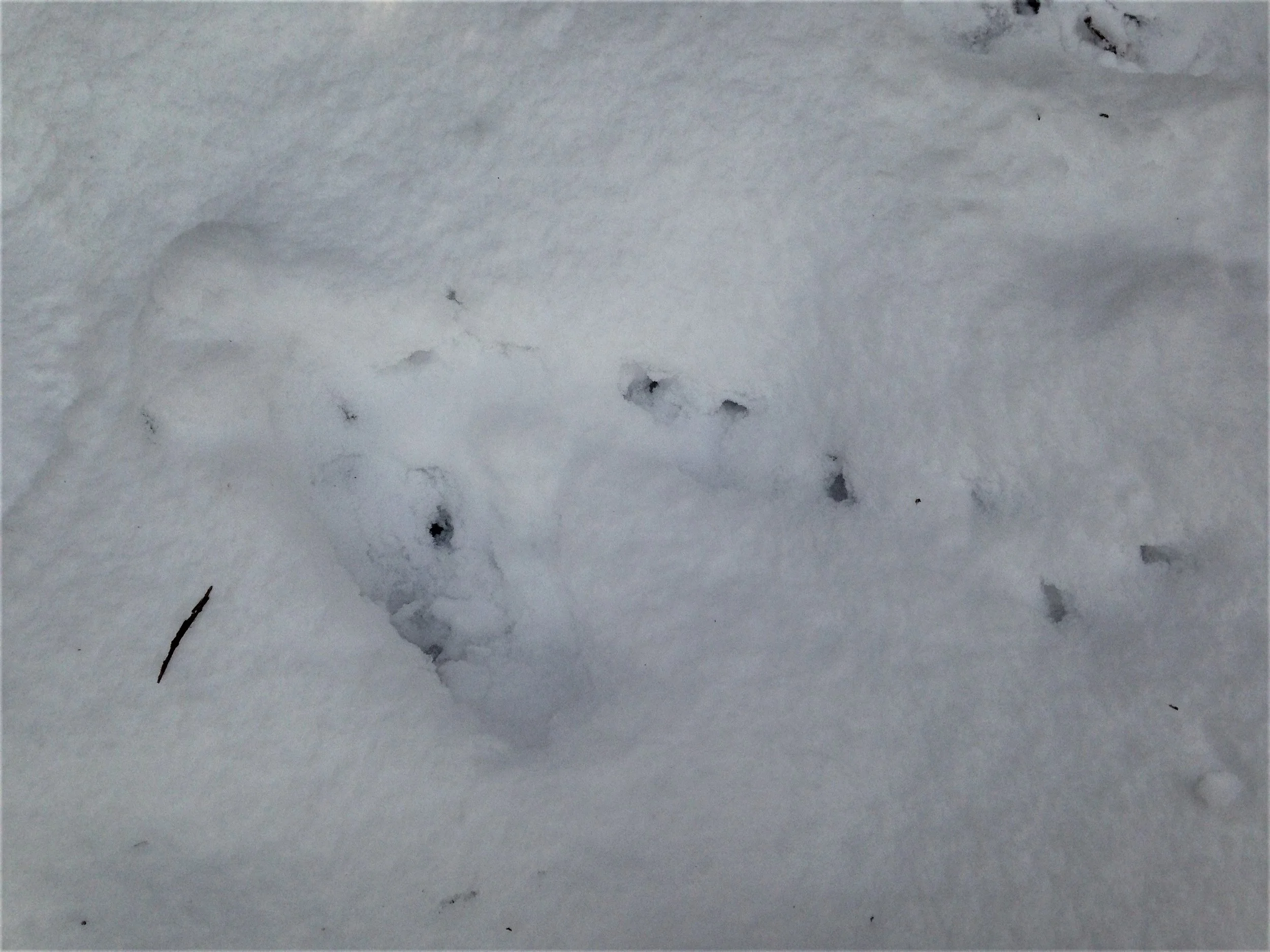
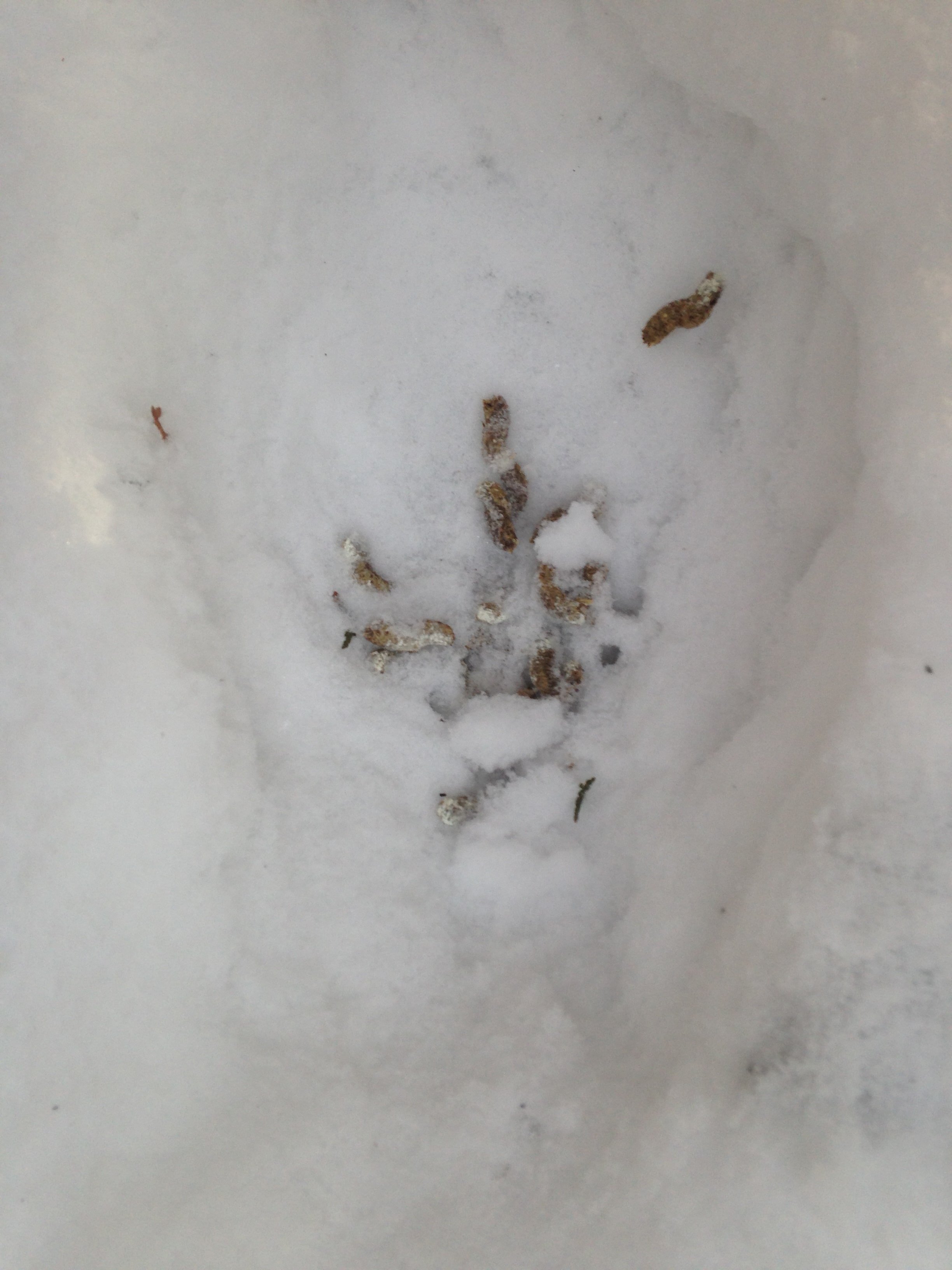
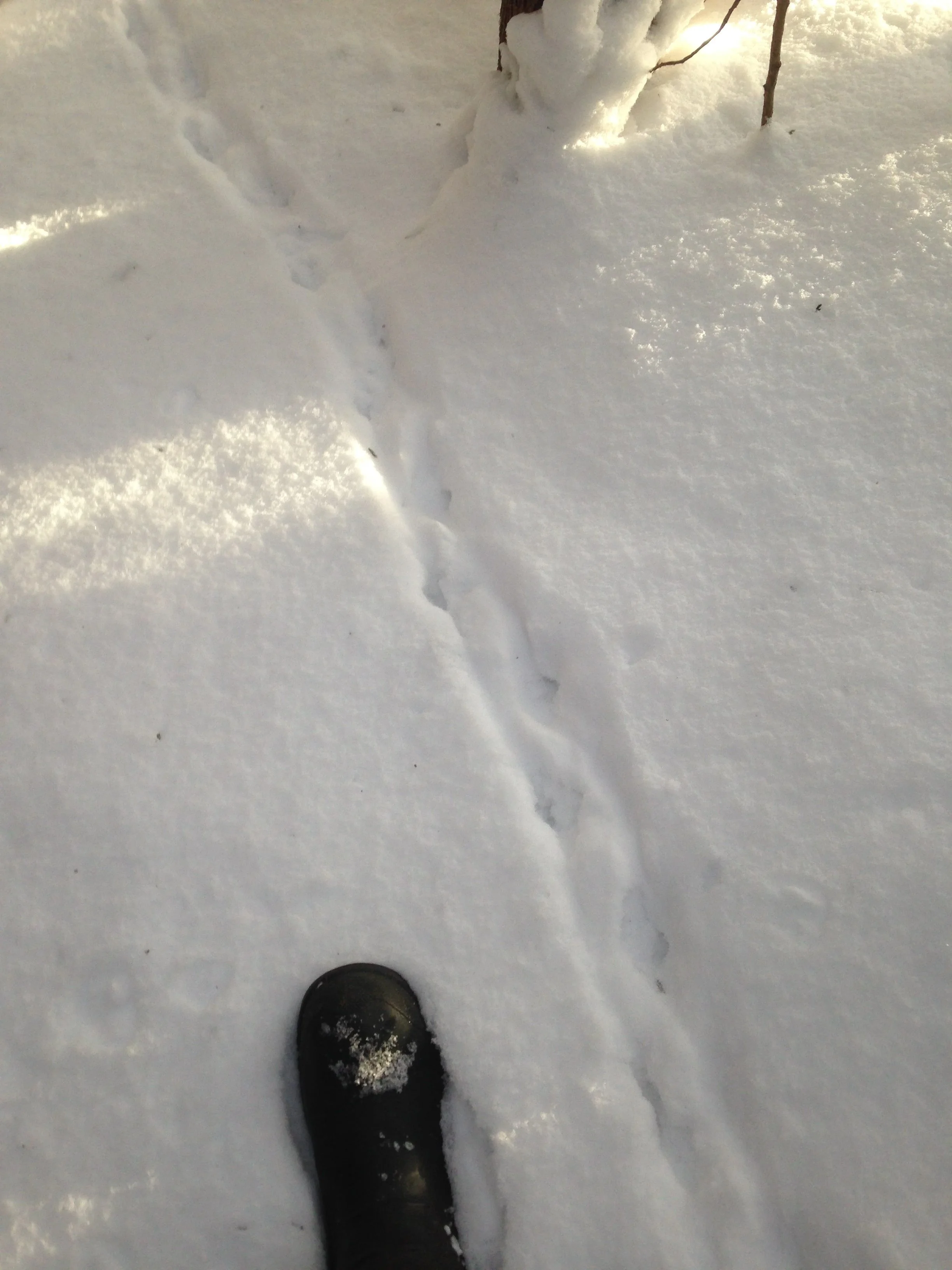
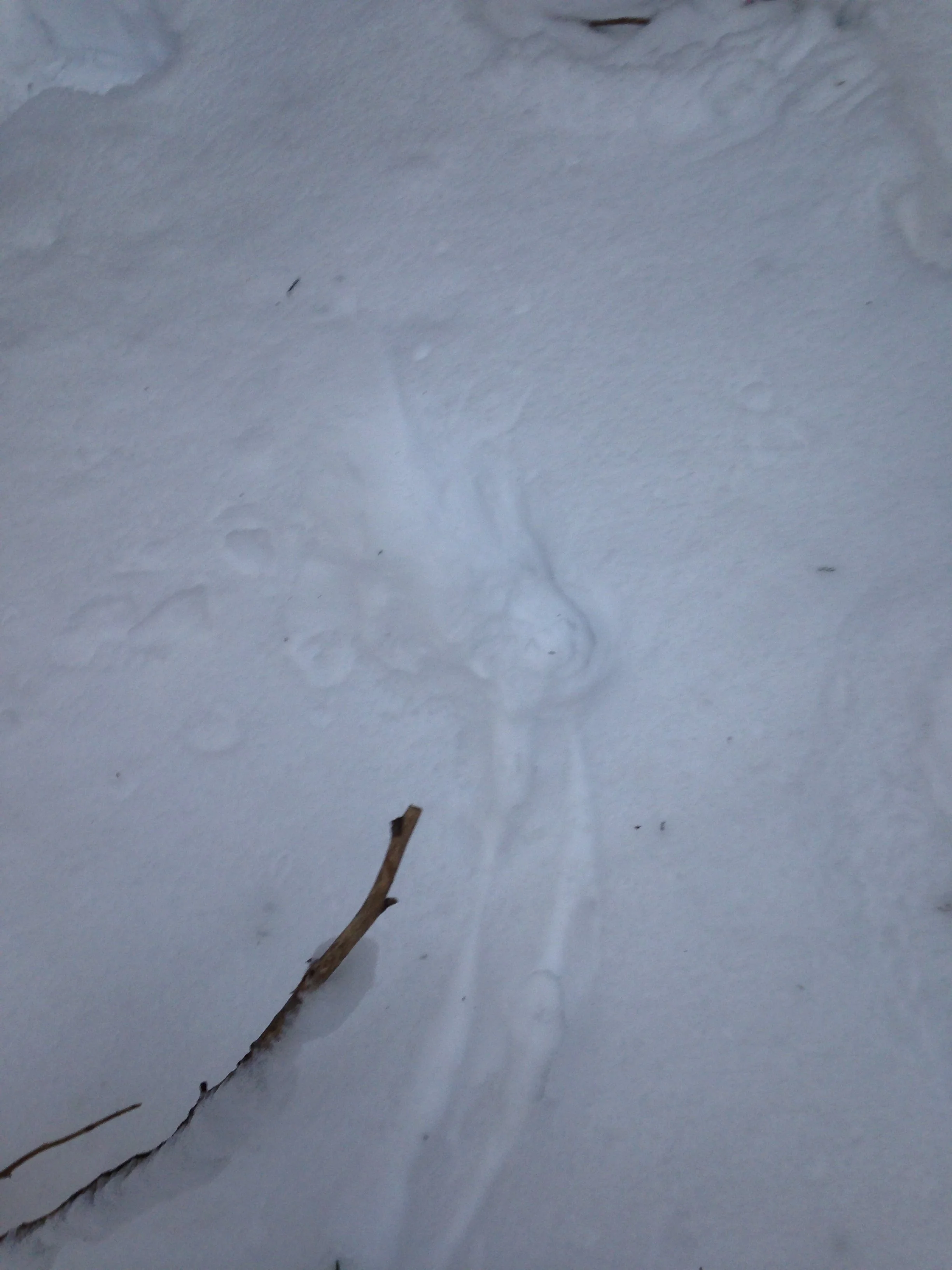
Ruffed Grouse were all around us in the forest when we arrived. Many were heard, some were seen, but even more so, their tracks littered the forest floor. There were these sunken oval impressions generally in the shape of a Grouse body pressed into the snow. We put our hands in despite the -20°C temperatures and felt the bottom the impressions. There was a hard icy crust in some of them, but not in others. There was scat in a couple, but not all. All had long chains of tracks emerging from them, but none had discernable tracks leading to them. What was going on?
I had seen images of Ruffed Grouse snow roosts in a couple of different books, but never really understood the steps that the Grouse takes to get down into the snow. Do they brush the snow with their wings? Dig it out with their strong feet? Peck the snow away? Turns out that Ruffed Grouse will both burrow into the snow (unsure yet of how), and dive bomb the snow, flying right into the drifts, when the snow is deep enough, roughly 15 - 20 cm (5 15/16 - 7 ⅞ in) deep. I honestly didn’t take the time to measure snow depth while we were out but measuring what I remember the snow depth being against the height of my boots I was wearing at the time, I believe that many areas through the woods had an accumulated depth of up to 20 cm (7 ⅞ in), which may be deep enough for one of the deep dive snow-roosts. Also, according to the article on Snow-roosting from the book “Ruffed Grouse” (Stackpole, 1989) the Grouse may instead burrow down into a snow-bowl roost which may only cover the lower body of the bird, leaving the upper body and head exposed. This is enough to help keep the bird warmer than they would be without ideal roosting conditions (dense conifer stands with greater coniferous basal area, stem density and increased canopy cover). The same “Ruffed Grouse” book says that the Grouse can heat up the surrounding air to just above freezing, making it so the Grouse has to spend little to no extra energy for thermoregulation because their feathers are so good at keeping them warm.
There was one paper that I read which studied the amount of stress hormone metabolites found in Ruffed Grouse scat in relation to temperature. When they looked at scats found in snow burrow roosts there was no apparent temperature induced stress hormone level changes than when the temperature was warmer. Where as scat deposited during cold temperature found outside of the snow roosts had higher levels of stress hormones. The snow-roosts seem then to reduce temperature related stress for the Ruffed Grouse. This makes sense to me, but sometimes is helpful to read that folks did the work to show this in the field, and by studying the scat no less!
I have read of differing views on whether the snow roosts are better for reducing predation or not. I would believe they are, as the bird remains hidden with only small visible signs to the presence of a Grouse under the snow. If it continued to snow after the bird has burrowed under, there would be no sign at all. Smell or auditory cues may be sign enough for predation from a Fox (Vulpes vulpes) or some other animal but I do not know any numbers on that. I bet coniferous tree roosting in preferred trees like Hemlock (Tsuga canadensis), Fir (Abies spp.), and Spruce (Picea spp.) would be safest for the Grouse, with snow-burrow roots coming in second, and snow-bowl roosts coming in third. That little Grouse head would be a giveaway for sure. And when it comes to comfort, I just don’t know. Grouse spend 19-23 hours a day roosting in mid-winter and I bet roosting in any or either situation for too long would get uncomfortable. They must switch it up once in a while.
I write all this about roosts, but I also don’t believe every Grouse shaped impression in the snow was the result of a roost. Some were likely caused by a quicker stay. As we walked through the woods and were spooking the Grouse folks started noticing the imprints of the birds had faint wing prints, rims of snow around one edge of them, and a chain of tracks leading out of the impressions. I was trying to not focus on my toes and take photos but sometimes it was hard to do either. I did get a chance to look over a couple of shoulders and noticed that Alexis was demonstrating how he could see that the Grouse had flown in (wing prints), landed in the snow (push up of snow along the rim of the imprint) turned and walked away (chain of tracks trailing away). The imprints were not only roosts, but also landing pads! It was another case of something being so obvious, but invisible to many of us. I wonder now about the scat in them. Were the scats only indicators of roosting stays or would a Grouse come in for a landing, lighten their load a little, and then walk away? That seems to make sense to me. Would the fibrous yellowy tubular uric-acid dabbed ones be in roosts while the squatty brown plop ones (cecal scats) only be found in others? Mark Elbroch, in Bird Tracks and Sign (Stackpole, 2001) describes them coming out sequentially. First the solid fibrous ones, and then the near-liquidy cecal scats second, but both of these scats are associated with roosts and there is nothing mentioning landings. This then becomes something to pay more attention for in the future.
I was reminded of a question that came to me a few years ago, and considering landing sites and emergences from roosts, it has come to mind again. How does a relatively large bird stay atop the light fluffy snow they are roosting within? This isn’t snow pack most of the time, but instead loose fresh snow. Why don’t they sink in? When this first came up someone tried to explain it to me, but it didn’t make sense until I found a dead Grouse stuck in the snow along a frozen river.
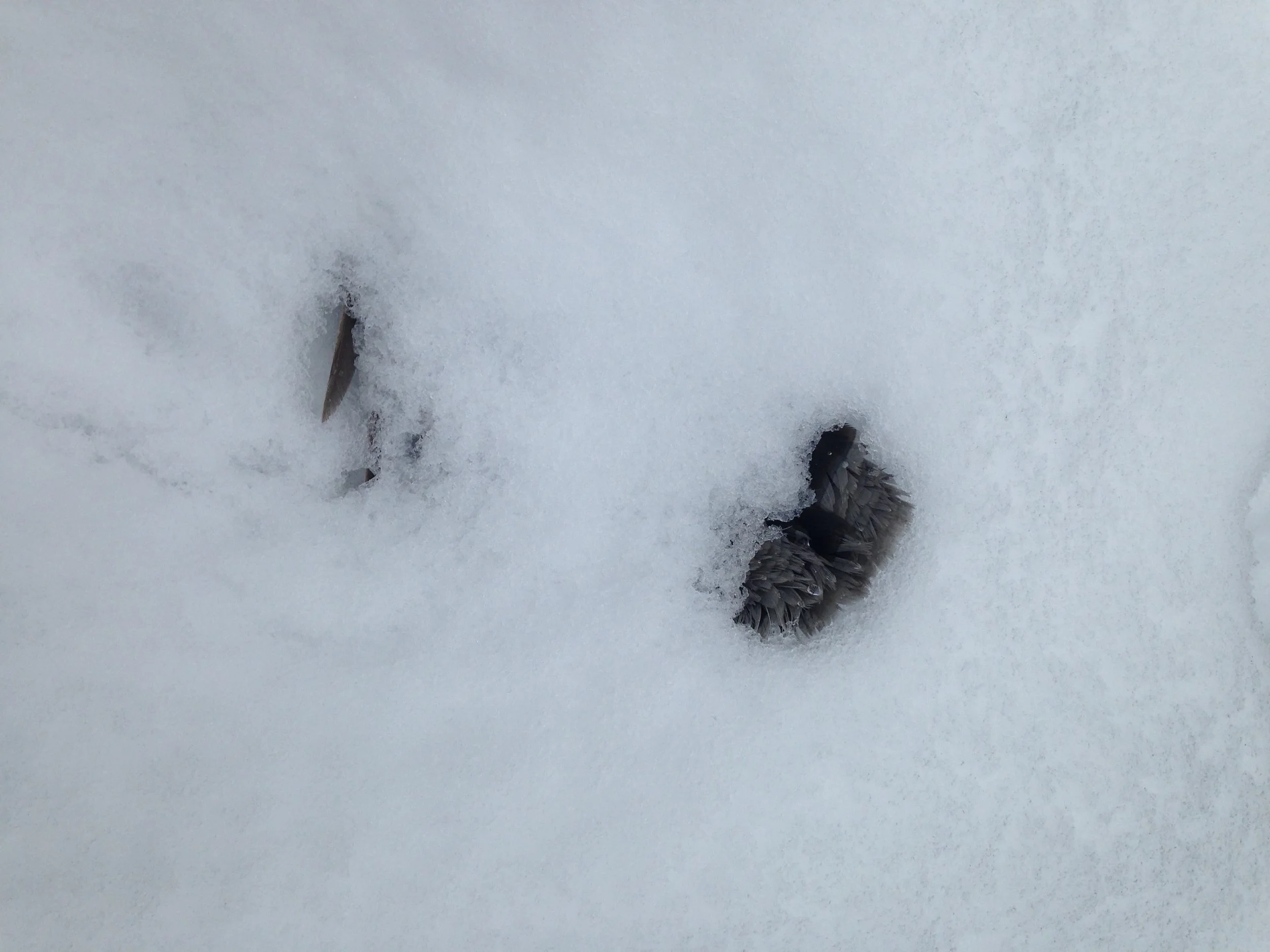
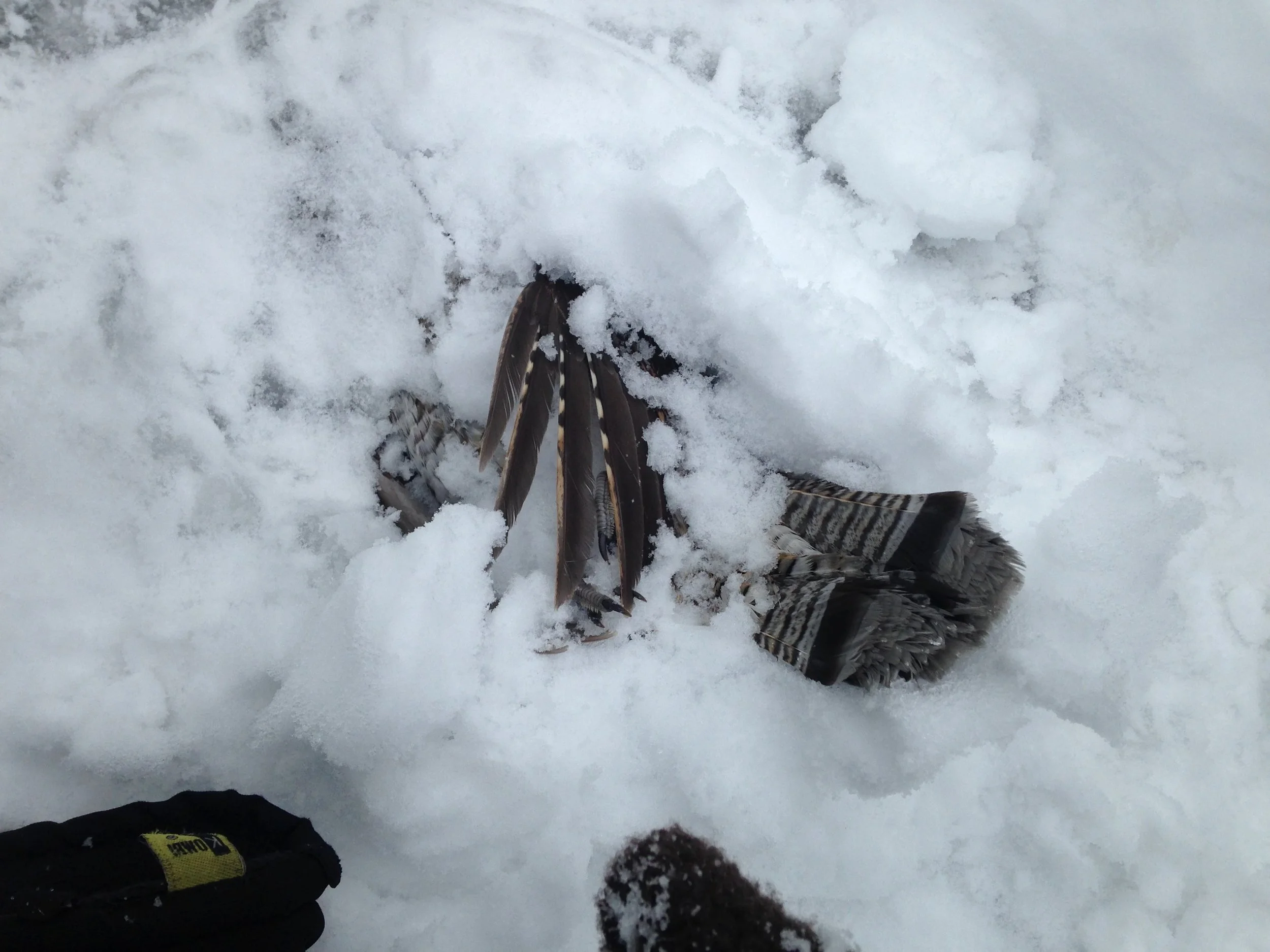
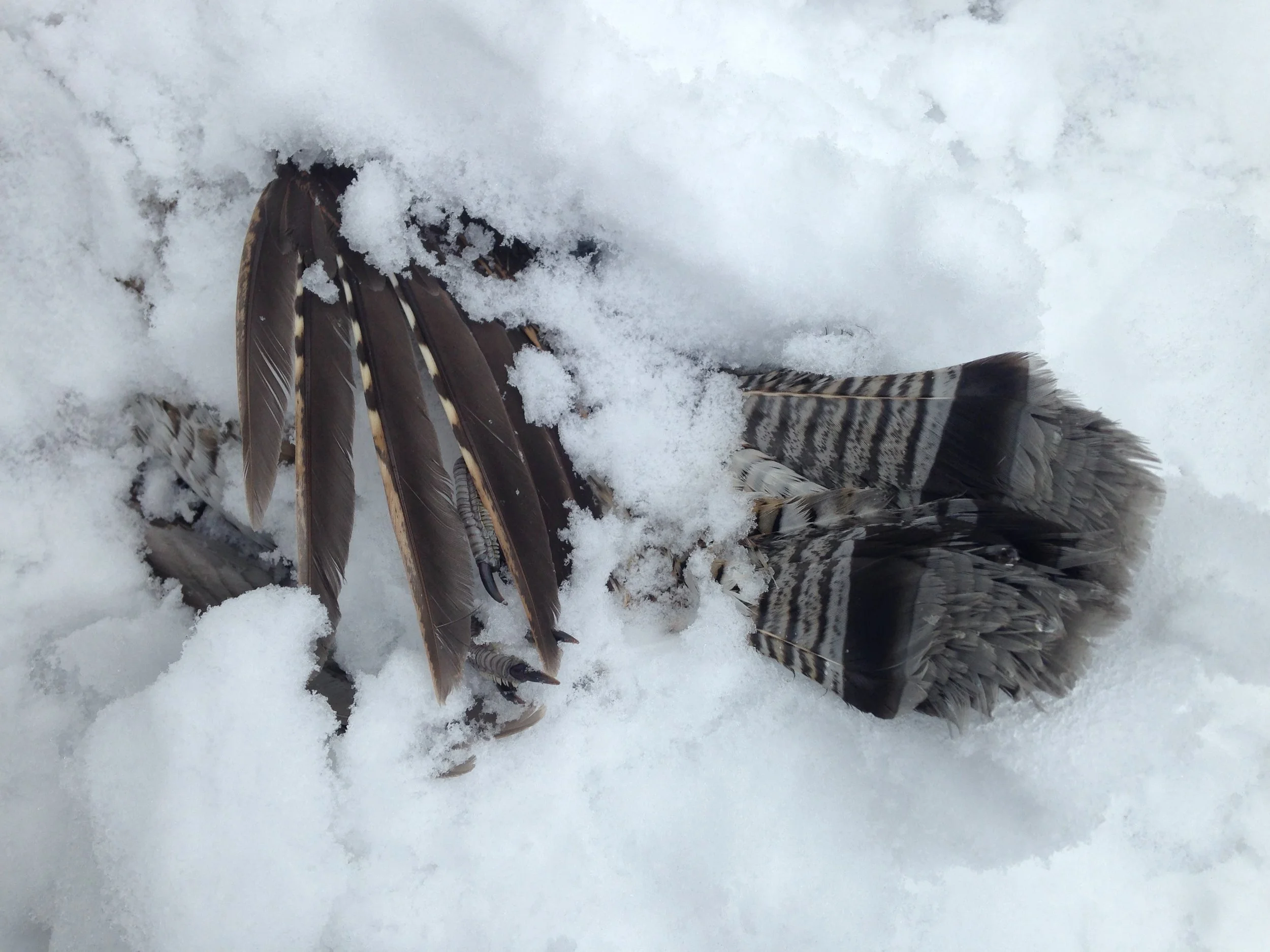
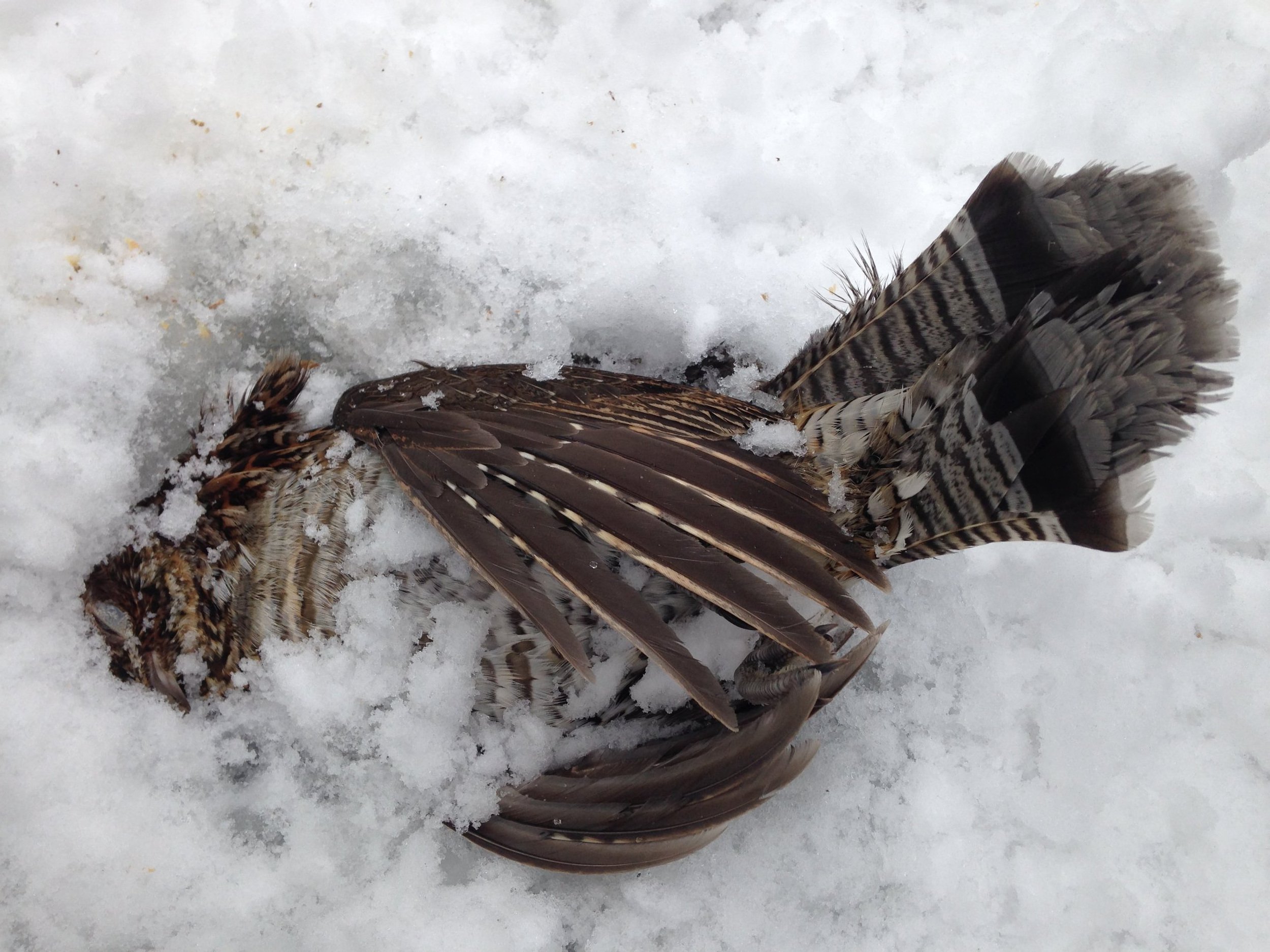
Beautiful feather patterns, including the dark ruff or collar around the neck.
Although the photos above may look like a snow-roost, it sadly was not. The Ruffed Grouse was found within a snow drift atop of an iced over river just beside a small one lane bridge. When we dug out the Grouse, we noticed that the bird had sunk down into the snow and the snow surrounding them had melted, and then froze again against the wings. This had to indicate that the time the bird touched the snow the Grouse was still warm enough to melt the surrounding snow. During the excavation we also noted that the bird’s head was also quite limp, as if the neck had been broken. My assumption, and that of one of the others with me was that the Grouse was likely on the road, or just off it when a vehicle drove by, spooking the bird into flight right into the path of the vehicle. The ensuing collision was enough to knock the bird over the guardrail and into the snow, where they sunk in and the snow surrounding them had covered them up, concealing and congealing them. When we took the bird back to camp we had the beautiful chance to examine all the amazingly ornate feathers, including the camouflaging wing patterns, and the dark and lovely ruff, after which they are named, in English (“Ruffed”) and Latin (the species name umbellus meaning umbrella, referencing the male's neck ruff).
Also examined at this kill site (it’s still a kill, but it was a vehicle) were the Ruffed Grouse’s feet. I had heard of some small projections coming from the feet which would help spread the weight, or create more surface area so as to prevent the Grouse from sinking too deeply into the snow, thereby losing more energy with every step. I assumed these projections were feathers or some feather like structure. Even though “ruff” and “rough” are spelled different I thought to a Rough-legged Hawk (Buteo lagopus), whose feet have feathers due to adaptations to living up North. Turns out they aren’t feathers, but instead comb-like growths or fringes which emerge from the toes in the Autumn and shed haphazardly in the Spring. When we found this Grouse I took photos of their pectinated feet and was in awe of how cool this adaptation to deep snow really was. This past year Rachelle from the apprenticeship also showed me some Grouse feet on October 10th which also had pectinations which seemed to be in a similar state of growth and wear. This gets me wondering when do these pectinations begin growing in? What triggers their onset? When do they start to fall off? Again, what triggers that?
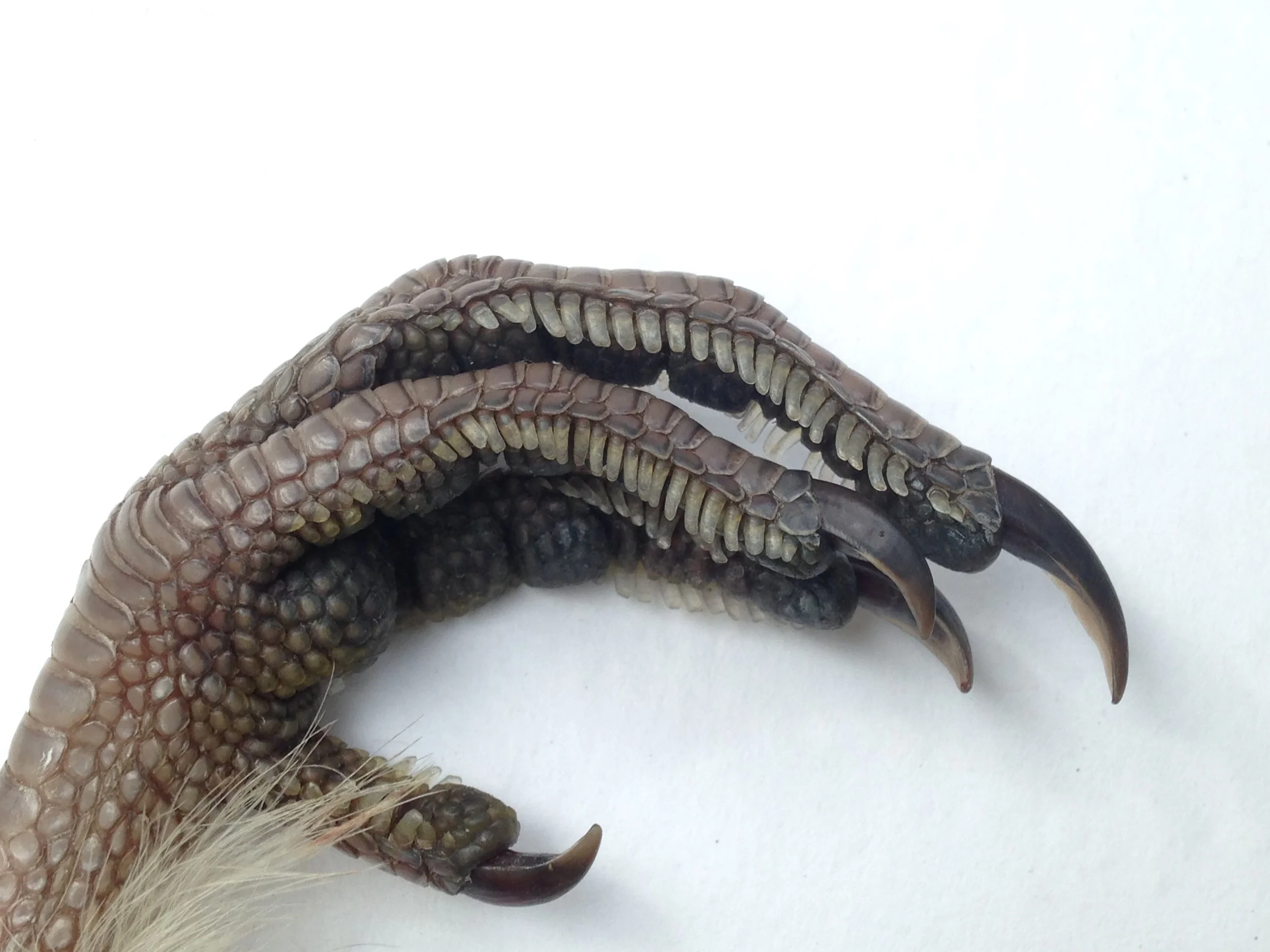
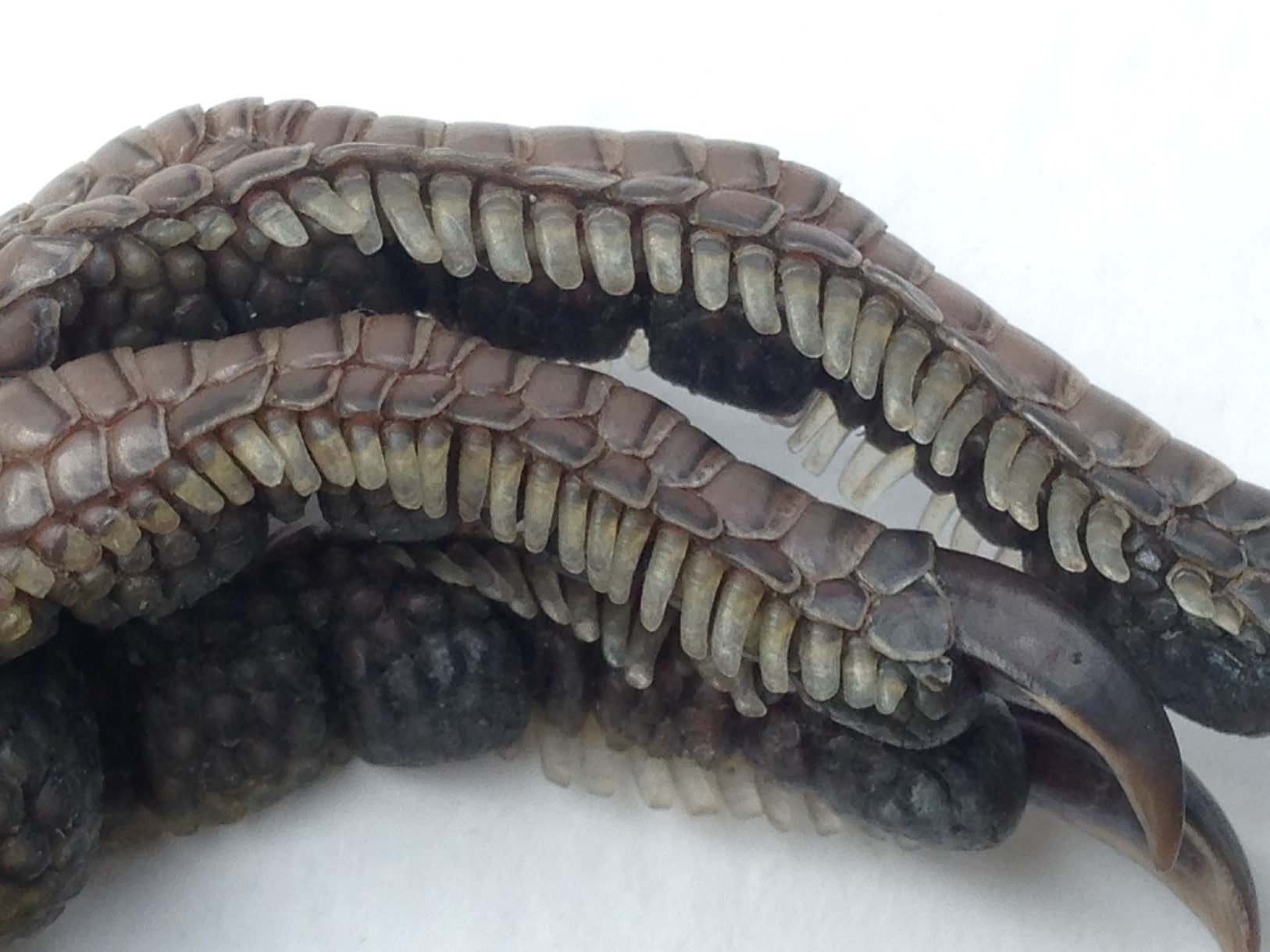
The same Ruffed Grouse book mentioned above (Stackpole, 1989) mentions that these pectinations tend to grow larger for the Grouse in the Northern part of their range, where along with the slight webbing on toes 2,3, and 4 may aid in float on the snow. But later in the book they mentioned that a researcher, G.W. Gullion believes that instead of acting as snowshoes the pectinations may help offer better grip on ice and snowy branches. I wonder about this too. These growths are kind of small and I just don’t know how much they would help. It would be fun to try and find out how big they are relative to our feet. Perhaps it would be worth building some for a pair of boots?
To learn more:
Atwater, Sally and Schnell, Judith. Ruffed Grouse. Harrisburg, PA, USA: Stackpole Books, 1989.
Night roost selection during winter by ruffed grouse in the central Appalachians
Winter selection of roost sites by ruffed grouse during daytime in mixed nordic-temperate forests, Quebec, Canada
Snow roosting reduces temperature‑associated stress in a wintering bird

